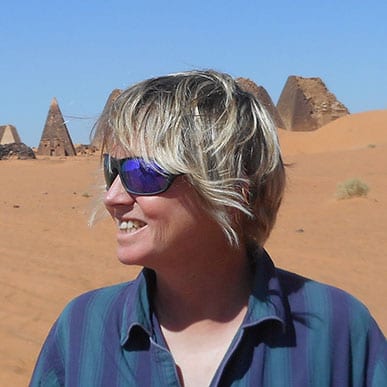Dr Julie Anderson is an archaeologist and curator of the Sudanese and Nubian collections of the British Museum. She’ll deliver the 23rd Maurice Kelly Lecture on 6 February.
From a very young age, Dr Julie Anderson just couldn’t resist the allure of hidden treasures and buried cities.
“As a child I read a book entitled ‘Gods, Graves and Scholars’ by C. W. Ceram. It related the exciting discovery of the tomb of Tutankhamun in Egypt, and also of Troy, the legendary city of Homer’s Iliad, in Turkey,” she says.
“I wanted to find lost cities like Heinrich Schliemann and ‘wonderful things’ just as Howard Carter, the excavator of Tutankhamun’s tomb, had done.”
As an archaeologist, Dr Anderson has been able to realise her childhood dreams, uncovering many aspects of daily life and culture in the Nile valley in archaeological excavations of sites across Egypt and Sudan since 1987.
And just like the books that captured her as a child, she’s currently uncovering the kind of treasures all archaeologists dream about: a previously unknown temple of the Egyptian and Kushite god Amun in exceptional condition, featuring fine decorated stone-wall panels, and a hoard of statues representing ancient rulers, including the celebrated Pharaoh Taharqo.
These are some of the discoveries at the archaeological site of Dangeil, once a thriving centre of an ancient Kushite kingdom on the southern border of the Roman Empire, in central Sudan, throwing unexpected light on African history, from antiquity into the medieval Christian period and later. And there’s plenty of surprising artefacts.
“Although the Sudanese Kushite kingdom lay on the southern border of the Roman Empire, a spectacular bronze head of the emperor Caesar Augustus was discovered in Meroe, the Royal City of the Kushite Rulers,” Dr Anderson says.
Dr Anderson will share her work and discoveries at the 23rd UNEMA Maurice Kelly Lecture at UNE, an event open to the public. She’s looking forward to the 60th anniversary celebration of UNE’s Museum of Antiquities, where a newly acquired Egyptian artefact for the museum will be unveiled.
“I can’t wait to see the mystery object being revealed at Booloominbah House. All artefacts tell a story and I am looking forward to hearing about this one’s journey, and what it can tell us about the people, environment and culture that made it. This will also be a good opportunity for me to discover some of Australia’s heritage in Booloominbah House itself.”
More information
More about the 23rd Maurice Kelly Lecture
Sign up for the event on Facebook.



Recent Comments